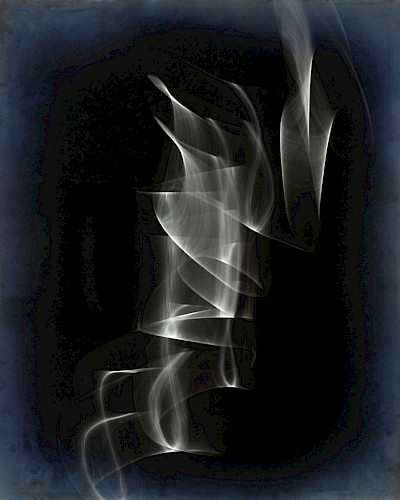untitled#
Artistically oriented experimental photography of the 1950s and 1960s, in which light itself is the object and coincidence becomes part of the composition principle, were the trigger for Thomas Ruff to get involved with this type of photography. It was in particular rhythmograms by Peter Keetman and Heinrich Heidersberger as well as metaforms by Etienne Bertrand Weill, which are characterised by abstract forms, graphic structures as well as a line play of light and shadow. Ruff was particularly interested in how those photographs had been created, what techniques had been used and what photographic, aesthetic and visual variations could be found.
Since he never stopped taking photographs himself, he used one of his cameras again for his visual research for untitled# for the first in a long while. First of all he constructed variously shaped wire structures, one of which he let float from the ceiling with the help of a nylon cord in front of a matt, black background. Then he made each wire structure rotate respectivly oscillate and photographed it with a longer exposure time. Thereby the moving wire object was no longer depicted, but only its traces of light. Depending on the speed of the movement and the rotation, the results varied and could not be controlled or predicted.
With this series, Ruff once again explores the history and various practices of photography - this time the 50s / 60s of the 20th century - and expands his reflection on the medium of photography with another alternative.

untitled#
Artistically oriented experimental photography of the 1950s and 1960s, in which light itself is the object and coincidence becomes part of the composition principle, were the trigger for Thomas Ruff to get involved with this type of photography. It was in particular rhythmograms by Peter Keetman and Heinrich Heidersberger as well as metaforms by Etienne Bertrand Weill, which are characterised by abstract forms, graphic structures as well as a line play of light and shadow. Ruff was particularly interested in how those photographs had been created, what techniques had been used and what photographic, aesthetic and visual variations could be found.
Since he never stopped taking photographs himself, he used one of his cameras again for his visual research for untitled# for the first in a long while. First of all he constructed variously shaped wire structures, one of which he let float from the ceiling with the help of a nylon cord in front of a matt, black background. Then he made each wire structure rotate respectivly oscillate and photographed it with a longer exposure time. Thereby the moving wire object was no longer depicted, but only its traces of light. Depending on the speed of the movement and the rotation, the results varied and could not be controlled or predicted.
With this series, Ruff once again explores the history and various practices of photography - this time the 50s / 60s of the 20th century - and expands his reflection on the medium of photography with another alternative.


















